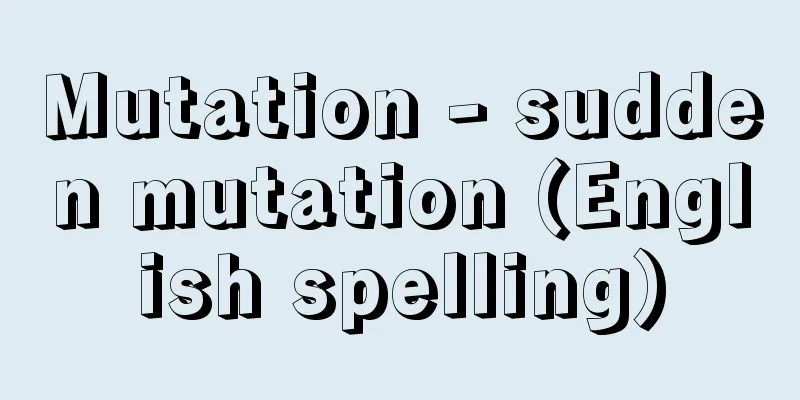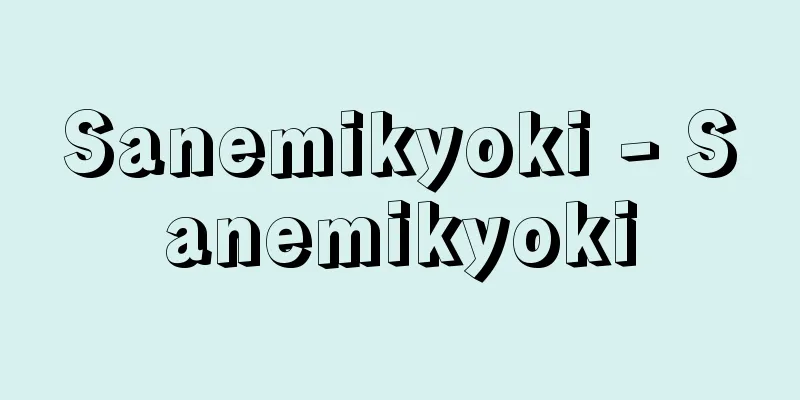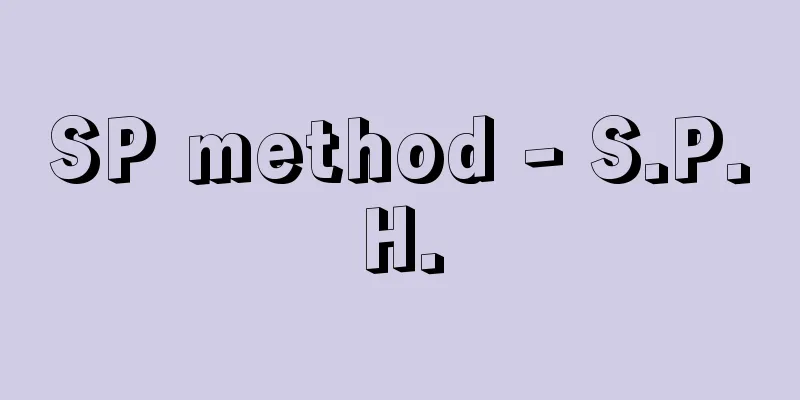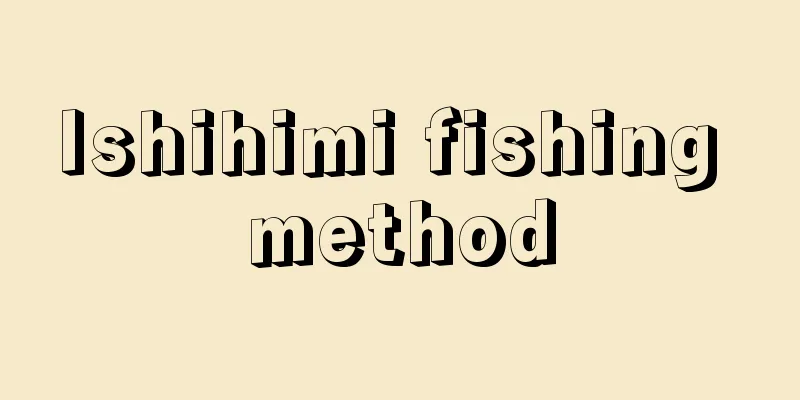Mutation - sudden mutation (English spelling)

|
Among the various mutations found in living organisms, this refers to a mutation that occurs due to a quantitative or qualitative change in genes. Therefore, a mutation is passed on to descendent cells or individuals unless it has a lethal effect. However, it does not include cases where a new trait appears due to the separation or genetic recombination of existing genes. The word mutation was first used in biology by the Dutchman de Vries, who named a genetic anomaly found in the evening primrose Oenothera (1901). Later, the American T. H. Morgan discovered the white-eyed mutation in the fruit fly Drosophila (1910), and H. J. Muller succeeded in artificially creating a mutation by irradiating fruit flies with X-rays (1928), making a great contribution to the subsequent development of genetics. Mutations can include changes of various degrees, from molecular level changes in which one of the bases in DNA (deoxyribonucleic acid), the main component of a gene, is replaced with another base, to changes in the structure or number of the chromosome in which the gene resides. [Kuroda Yukiaki] Mutation classificationFirst, there are molecular level changes such as base changes, deletions, additions, inversions, duplications, and frame shifts of DNA. In these cases, changes occur such that enzymes or proteins produced by the genetic information in the DNA are no longer produced or lose their activity. Such mutations that affect the function of a single gene are called gene mutations or point mutations. Mutations that occur due to changes in the structure or number of chromosomes on which genes reside are called chromosome mutations or chromosome aberrations. Changes in the number of chromosomes include polyploidy, in which the entire set of chromosomes (genome) increases by an integer multiple, trisomy or monosomy, in which only one specific chromosome is added or removed, and heteroploidy, in which several chromosomes are added or removed. Changes in the structure of chromosomes include deletions, duplications, and inversions within a single chromosome, as well as translocations, which are rearrangements between chromosomes. When the changes caused by these mutations are recognized as morphological traits, they are called morphological mutations or visible mutations. When the mutations cause cells or individuals to become unable to survive, they are called lethal mutations. When normal or wild-type cells or individuals undergo mutations, they are called forward mutations, and when a mutated cell or individual undergoes a mutation in the same location and reverts to its original normal or wild-type state, they are called reverse mutations (or back mutations). [Kuroda Yukiaki] Mutation frequencyMutations occur at a certain low frequency even in nature, without any external artificial intervention. This is called a spontaneous mutation, and its frequency varies depending on the type of organism and the type of gene. The frequency per gene locus per generation is very low in microorganisms, at 1 in 100 million to 1 billion mutations, but is relatively high in higher plants and animals, at 1 in 100,000 to 1 million mutations. In humans, ankylosing of the limbs occurs about 5 times in 100,000, hemophilia occurs about 3 times in 100,000, aniridia and microphthalmia each occur about once in 1 million mutations. The frequency of mutations can be artificially increased by exposing organisms to radiation such as X-rays, gamma rays, and ultraviolet rays, as well as various mutagenic chemicals and carcinogens. Such artificially induced mutations are called induced mutations. The frequency of mutations increases in proportion to the dose and exposure time of the radiation used, the concentration and treatment time of the chemicals, etc. [Kuroda Yukiaki] Use of mutationsSince artificial mutations began to be induced, these mutations have been used to study the genetic interactions of many organisms and to analyze the biochemical metabolic processes of the synthesis and decomposition of various biological components, making immeasurable contributions to the fields of genetics, developmental biology, and biology. In addition, mutations are used in the practical applications of plant breeding, agriculture, animal husbandry, and other fields, as well as the development and improvement of naturally and artificially mutated strains that produce large amounts of many antibiotics, such as penicillin and streptomycin, and the development of microbial strains that produce large amounts of specific amino acids, proteins, and other useful substances. Since around 1970, the mutagenicity of many mutagens and carcinogens that exist in the environment, such as food, medicines, and pesticides, has been investigated using detection systems from various organisms, such as cultured cells of microorganisms and mammals, insects, plants, and laboratory animals, in order to predict the risk to humans of these substances and to eliminate them from the environment as much as possible. [Kuroda Yukiaki] "Heredity and Mutation," edited by Ashida Joji et al. (1958, Kyoritsu Shuppan)" ▽ "Plant Genetics 4: Morphogenesis and Mutation," edited by Yamaguchi Hikoyuki (1977, Shokabo)" ▽ "Mutation Breeding," written by Yamaguchi Hikoyuki et al. (1983, Yokendou)" ▽ "Genetics, volumes 1 and 2, written by R.H. Tamarin, supervised translation by Kimura Motoo, translated by Fukuda Ichiro et al. (1988, Baifukan)" ▽ "Genetics Notes: Drosophila and Me," written by Moriwaki Daigoro (1988, Academic Press Center)" ▽ "New Edition Illustrated Biology," written by Oshima Yasuyuki et al. (1988, Asakura Shoten)" ▽ "Microbiology, volume 1, written by R.Y. Stanier et al., translated by Takahashi Hajime et al. (1989, Baifukan)" ▽ "Lectures on Experimental Methods in Genetics 5," edited by Kuroda Yukiaki "Experimental Methods in Animal Genetics" (1989, Kyoritsu Shuppan)" ▽ "Molecular Biology, Vol. 1, by D.M. Freifelder, translated by Shimura Reiro et al. (1989, Kagaku Dojin)" ▽ "Protein Engineering" by Okada Yoshimi (1989, Tokyo Kagaku Dojin)" ▽ "Biology of the Medaka, edited by Egami Nobuo et al. (1990, University of Tokyo Press)" ▽ "Rice Breeding" by Yomohara Yuzo (1990, University of Tokyo Press)" ▽ "Fundamentals of Human Genetics, by Kondo Kiyotaro et al. (1990, Nanzando)" ▽ "Introduction to Experimental Procedures in Biotechnology" by Shiba Tadayoshi (1990, Kodansha)" ▽ "Molecular Biology in Pharmaceutical Sciences, edited by Natori Shunji (1990, Kodansha)" ▽ "Modern Genetics" by P.J. Russell, supervised by Ota Jiro, translated by Imaizumi Saeko and Shimizu Kumiko (1990, Ohmsha)" ▽ "Molecular Evolutionary Genetics" by Nei Masatoshi (1990, Baifukan)" ▽ "Genetics Introduction" by J.F. Crow, translated by Kimura Motoo, Kitagawa Osamu and Ota Tomoko (1991, Baifukan)" ▽ "Human Genetics" by G. Edlin, supervised by Shimizu Nobuyoshi, translated by Ito Fumiaki et al. (1992, Tokyo Kagaku Dojin)" ▽ "Plant Breeding: Basics and Applications" by Fujimaki Hiroshi et al. (1992, Baifukan)" ▽ "Breeding and Bioscience: New Trends in Breeding" edited by Yomohara Yuzo (1993, Youkendou)" ▽ "Fundamentals of Molecular Biology, 2nd Edition, by D.M. Freifelder et al., translated by Kawakita Masao (1994, Tokyo Kagaku Dojin)" ▽ "Genetics of Animal Populations, by Nozawa Ken (1994, Nagoya University Press)" ▽ "The Mechanism of Heredity, edited by Ota Jiro et al. (1995, Asakura Shoten) " ▽ "Genetics for the 21st Century 1: Basic Genetics, edited by Kuroda Yukiaki (1995, Shokabo)" ▽ "Radiation Biology, by Yamaguchi Hikoyuki (1995, Shokabo)" ▽ "Experimental Methods in Yeast Molecular Genetics, edited by Oshima Yasuharu, Komano Toru et al. (1996, Academic Press Center)" ▽ "Rice Breeding Manual, edited by Yamamoto Ryuichi et al. (1996, Yokendou)" ▽ "Molecular Genetics, edited by Miura Kin'ichiro (1997, Shokabo)" ▽ "Molecular Genetics" edited by Haruo Momose (1997, Maruzen)" ▽ "Manipulating Genes: When Rose-Colored Promises Turn to Nightmares" by Mae-Wan Ho, translated by Motohiko Ozawa (2000, Sankosha)" ▽ "Introduction to Modern Evolutionary Science" by Colin Patterson, translated by Shunsuke Mawatari et al. (2001, Iwanami Shoten)" ▽ "Radiation Biology" edited by Yosuke Ejima and Hiroshi Kimura, edited by the Japanese Society of Radiation Technology (2002, Ohmsha) " ▽ "Genetics of Bacteria and Phages: The Foundations of Molecular Biology and Biotechnology" by E.A. Burge, translated by Hideo Takahashi et al. (2002, Springer-Verlag Tokyo)" ▽ "An Enlightening Introduction to Genetics and DNA Science: From Darwin to Gene Therapy" by Steve Jones, illustrated by Bolin van Loon, translated by Daisuke Yamamoto (2003, Kodansha)" ▽ "Ukai Yasuo, 'Plant Breeding Science: From Hybridization to Genetic Modification' (2003, University of Tokyo Press)" ▽ "Kimura Motoo, 'Thinking about Biological Evolution' (Iwanami Shinsho)" [References] | | | | | | | | | | | | | | | |biochemistry| | | | | | | | | | | | | | | | | |©Shogakukan "> Classification of mutations (molecular level) Source: Shogakukan Encyclopedia Nipponica About Encyclopedia Nipponica Information | Legend |
|
生物にみられる種々の変異のうち、遺伝子の量的または質的な変化によって生じた変異をいう。したがって突然変異は、それが致死作用をもっていない限りは子孫の細胞や個体に伝えられる。ただし、すでに存在する遺伝子の分離や遺伝的組換えによって新しい形質が現れる場合は含まれない。突然変異のことばを生物学上で初めて使用したのはオランダのド・フリースで、オオマツヨイグサOenotheraにみいだされた遺伝的な変わりものに対して名づけた(1901)。その後、アメリカのT・H・モーガンが、ショウジョウバエ属Drosophilaで白眼の突然変異をみいだし(1910)、さらにH・J・マラーが、ショウジョウバエにX線を照射して人為的に突然変異を作成することに成功して(1928)、その後の遺伝学の発展に大きく貢献した。 突然変異は、遺伝子の本体であるDNA(デオキシリボ核酸)の塩基の一つが他の塩基に置き換わった分子レベルの変化から、遺伝子の存在する染色体の構造や数の変化したものなど、種々の程度の変化が含まれる。 [黒田行昭] 突然変異の分類まず、DNAの一つまたは多数の塩基の置換base change、欠失deletion(またはdeficiency)、付加addition、逆位inversion、重複duplicationなどや塩基の枠組み移動flame shiftのような分子レベルでの変化がある。この場合は、そのDNAのもつ遺伝情報によってつくられる酵素やタンパク質がつくられなくなったり、活性が消失したりするような変化が現れる。このような一つの遺伝子の作用に影響を与えるような突然変異を遺伝子突然変異gene mutationまたは点突然変異point mutationという。 遺伝子の存在する染色体の構造や数の変化によって生ずる突然変異を染色体突然変異chromosome mutationまたは染色体異常chromosome aberrationという。染色体の数の変化としては、染色体の全体のセット(ゲノム)が整数倍で増加する倍数性polyploidyや、ある特定の染色体のみが1本増加したり減少したりするトリソミーtrisomyやモノソミーmonosomy、数本の染色体が増減する異数性heteroploidyなどがある。また、染色体の構造の変化としては、1本の染色体のなかでの欠失や重複、逆位などのほか、ほかの染色体との間でのつなぎ換えとして転座translocationがある。 これらの突然変異によって生じた変化が、形態的な形質として認められる場合は形態的突然変異morphological mutationまたは可視突然変異visible mutationという。また、生じた突然変異によって細胞や個体が生存できなくなるものを致死突然変異lethal mutationという。正常または野生型の細胞や個体が突然変異をおこす場合を前進突然変異forward mutationといい、突然変異をおこした細胞や個体が、同じ場所に突然変異をおこして、ふたたびもとの正常または野生型に戻る場合を復帰突然変異reverse mutation(またはback mutation)という。 [黒田行昭] 突然変異の頻度突然変異は、外から人為的に手を加えなくとも、自然の状態においてもある一定の低い頻度でおこる。これを自然突然変異spontaneous mutationというが、その頻度は生物の種類や遺伝子の種類によって異なり、1遺伝子座当り世代当りの頻度は、微生物では1億から10億回に1回の割合で非常に低いが、高等動植物では10万から100万回に1回の割合と比較的高い。ヒトでは四肢短縮症が10万回に5回くらい、血友病が10万回に3回くらい、無虹彩(むこうさい)症や小眼球症がそれぞれ100万回に1回くらいの割合でおこる。 X線やγ(ガンマ)線、紫外線などの放射線や種々の変異原性化学物質、発癌(はつがん)物質などを作用させると、突然変異の頻度が人為的に上昇する。このような人為的に誘発された突然変異を誘発突然変異induced mutation(人為突然変異)という。そのときの突然変異の頻度は、使用した放射線の線量や照射時間、化学物質の濃度や処理時間などに比例して増大する。 [黒田行昭] 突然変異の利用突然変異が人為的につくられるようになってから、これらの突然変異を利用して、多くの生物の遺伝子の連関関係の研究や、種々の生体構成成分の合成や分解の生化学的代謝過程の解析が行われ、遺伝学、発生学、生物学の各学問分野における貢献は計り知れないものがある。また、突然変異の実際的な利用としては、植物の品種改良など育種学、農学、畜産学などの各分野における利用のほか、ペニシリン、ストレプトマイシンなど多くの抗生物質を多量に生産する自然および人為突然変異の菌株の開発や改良、特定のアミノ酸やタンパク質その他の有用物質を多量に生産する微生物の株の開発などにも利用されている。また1970年ごろから、食品や医薬品、農薬など環境中に存在する多数の変異原物質や発癌物質の人間に対する危険度を予測し、これらを環境中からできるだけ排除するために、微生物や哺乳(ほにゅう)類の培養細胞、昆虫、植物、実験動物など種々の生物の検出系を使って、これらの物質の突然変異性の調査も行われている。 [黒田行昭] 『芦田譲治他編『遺伝と変異』(1958・共立出版)』▽『山口彦之編『植物遺伝学4 形態形成と突然変異』(1977・裳華房)』▽『山口彦之他著『突然変異育種』(1983・養賢堂)』▽『R・H・タマリン著、木村資生監訳、福田一郎他訳『遺伝学』上下(1988・培風館)』▽『森脇大五郎著『遺伝学ノート――ショウジョウバエと私』(1988・学会出版センター)』▽『大島康行他著『新版 図説生物学』(1988・朝倉書店)』▽『R・Y・スタニエ他著、高橋甫他訳『微生物学』上(1989・培風館)』▽『黒田行昭編『遺伝学実験法講座5 動物遺伝学実験法』(1989・共立出版)』▽『D・M・フライフェルダー著、志村令郎他訳『分子生物学』上(1989・化学同人)』▽『岡田吉美著『プロテインエンジニアリング』(1989・東京化学同人)』▽『江上信雄他編『メダカの生物学』(1990・東京大学出版会)』▽『蓬原雄三著『イネの育種学』(1990・東京大学出版会)』▽『近藤喜代太郎他著『人類遺伝学の基礎』(1990・南江堂)』▽『柴忠義著『バイオテクノロジー実験操作入門』(1990・講談社)』▽『名取俊二編『薬科分子生物学』(1990・講談社)』▽『P・J・ラッセル著、太田次郎監訳、今泉佐枝子・清水久美子訳『現代遺伝学』(1990・オーム社)』▽『根井正利著『分子進化遺伝学』(1990・培風館)』▽『J・F・クロー著、木村資生・北川修・太田朋子訳『遺伝学概説』(1991・培風館)』▽『G・エドリン著、清水信義監訳、伊藤文昭他訳『ヒトの遺伝学』(1992・東京化学同人)』▽『藤巻宏他著『植物育種学 基礎編』『植物育種学 応用編』(1992・培風館)』▽『蓬原雄三編著『育種とバイオサイエンス――育種学の新しい流れ』(1993・養賢堂)』▽『D・M・フライフェルダー他著、川喜田正夫訳『分子生物学の基礎』第2版(1994・東京化学同人)』▽『野沢謙著『動物集団の遺伝学』(1994・名古屋大学出版会)』▽『太田次郎他編『遺伝のしくみ』(1995・朝倉書店)』▽『黒田行昭編著『21世紀への遺伝学1 基礎遺伝学』(1995・裳華房)』▽『山口彦之著『放射線生物学』(1995・裳華房)』▽『大嶋泰治編著、駒野徹他編『酵母分子遺伝学実験法』(1996・学会出版センター)』▽『山本隆一他編『イネ育種マニュアル』(1996・養賢堂)』▽『三浦謹一郎編『分子遺伝学』(1997・裳華房)』▽『百瀬春生編『分子遺伝学』(1997・丸善)』▽『メイワン・ホー著、小沢元彦訳『遺伝子を操作する――ばら色の約束が悪夢に変わるとき』(2000・三交社)』▽『コリン・パターソン著、馬渡峻輔他訳『現代進化学入門』(2001・岩波書店)』▽『日本放射線技術学会監修、江島洋介・木村博編『放射線生物学』(2002・オーム社)』▽『E・A・バージ著、高橋秀夫他訳『バクテリアとファージの遺伝学――分子生物学・バイオテクノロジーの基盤』(2002・シュプリンガー・フェアラーク東京)』▽『スティーヴ・ジョーンズ著、ボリン・ヴァン・ルーン画、山元大輔訳『超図説 目からウロコの遺伝・DNA学入門――ダーウィンから遺伝子治療まで』(2003・講談社)』▽『鵜飼保雄著『植物育種学――交雑から遺伝子組換えまで』(2003・東京大学出版会)』▽『木村資生著『生物進化を考える』(岩波新書)』 [参照項目] | | | | | | | | | | | | | | | | | | | | | | | | | | | | | | | | | |©Shogakukan"> 突然変異の分類(分子レベル) 出典 小学館 日本大百科全書(ニッポニカ)日本大百科全書(ニッポニカ)について 情報 | 凡例 |
<<: Mutation breeding - Totsuzenhen Iikushu (English spelling)
>>: Sudden rise in temperature
Recommend
Reverse
…It refers to painting the same color family in a...
Gas turbine cycle
…jet engine [Theory and thermal efficiency] The o...
Kyui - Kyui (English notation) Цезарь Антонович Кюи/Tsezar' Antonovich Kyui
Russian composer and music critic. He received ba...
Ge-le Ke-han (English: Ko-lê K`ê-han)
[raw]? [Death] 759 The second Khagan of the Uighur...
Enharmonic Conversion - Enharmonic Conversion
…An enharmonic interval is an interval that is no...
Balkh (English spelling)
A town in Balkh Province in north-central Afghanis...
Itys
…the sister of Prokne, who was married to the Thr...
Fox torch - Fox torch
A mushroom of the Basidiomycete/Gastromycete orde...
Helsinki - Helsinki (English spelling)
The capital of Finland. Population: 559,718 (2001...
Miyasudokoro - Palace
A title for the ladies who served in the emperor&...
Gastrodia nipponica (English name) Gastrodianipponica
…[Nitta Aya]. . . *Some of the terminology that m...
Dogra Magura
A full-length novel by Yumeno Kyusaku. Published i...
Okayama Iroha Club
…In tandem with the Socialist Association, he fre...
Kasuri thread
…The etymology is from the Malay word mengikat, w...
Zor'yan, S.
...After parts of Armenia were annexed by Russia,...









